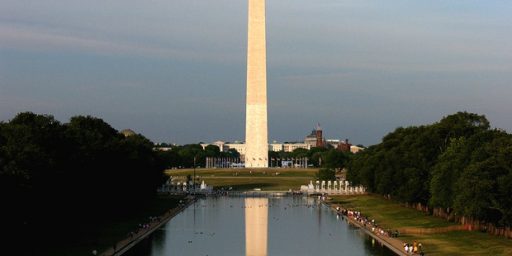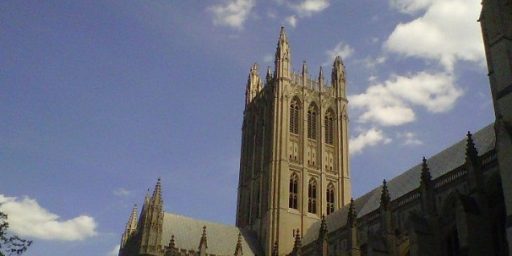D.C. an Armed Camp?
NYT: Security Efforts Turning Capital Into Armed Camp
An antiaircraft missile, ready for use, sits atop a federal office building near the White House. Devices that test the air for chemical and biological substances are positioned throughout the city. Subway stations are now equipped with “bomb containment” trash bins. A major highway that runs by the Pentagon is being rerouted several hundred yards away. A security wall is going up around the Washington Monument.
Day by day, the nation’s capital is becoming a fortress, turning a city known for graceful beauty into a virtual armed camp. In response to the Sept. 11, 2001, terrorist attacks, federal security agents along with their counterparts in the Washington, Maryland and Virginia governments began a huge effort to build permanent safeguards for the capital area’s most important buildings and monuments.
The effort that built slowly after the 1995 bombing of a federal building in Oklahoma City intensified after one jetliner slammed into the Pentagon and another jet crashed in Pennsylvania, presumably on its way to a target in Washington.
But more recently, security efforts have gained a new urgency as officials seek ways to stop truck bombs and other terrorist tactics that have been used in other countries, like suicide bombers.
Some of the biggest projects are under way at the most visible symbols of American democracy and might — the White House, the Capitol, the Washington Monument and the Pentagon.
A result has been a surge of security construction at a cost, still being calculated, that is expected to reach several hundred million dollars within five or six years. Barely 20 percent of the security measures planned for the region have been designed, let alone completed, which means construction is certain to continue for years.
“I’m not sure we ever reach a point where everything has been done; it’s an ongoing process,” said Kenneth E. Wall, an official with the Department of Homeland Security who oversees activity in the capital region. “As threats evolve and information evolves, we have to make adjustments accordingly.”
But even at this early stage, the security efforts have transformed large parts of Washington, creating a slightly ominous feel for the city’s 572,000 residents and the million more people who work here and visit daily. Tony Bullock, an aide to Mayor Anthony A. Williams, called it “the uglification of Washington.” Unlike New York and other cities that have fewer federal buildings and, thus, a less concentrated security presence, Washington has a dense core of buildings that house every department of the federal government and venerated monuments that honor the country’s greatest leaders.
While I agree that some of these measures are a bit of overkill, the impact on daily life in Washington is wildly exaggerated. I go into the city on a fairly regular basis and find the poor road system and the lack of enforcement of traffic regulations (allowing delivery vehicles and vendors to block driving lanes during peak weekday hours, for example) to be much more of a hindrance than the security measures. One can still visit the Mall and all the museums and whatnot with rather minimal intrusion on one’s enjoyment.
And, please, the city’s residents don’t live in the parts of the city –maybe five square miles?– that are effected by this.





Understanding, or even familiarity, has never been a requirement for the NYT to form an opinion, especially when they’re looking down their nose at someone.
Not that I’m an apologist for D.C. I mean, really: Marion Barry. ‘Nuff sed.
If you ride metro on a regular basis as I used to do, it is astounding to me how vulnerable that system is to an attack. I cannot see anything outside of an occasional police K-9 patrol at the Galery Place station that would even hint of increased security.
As best I can tell, the difference is those Beirut-style crash barricades in front of prominent landmarks, having to pass through airport-style security checks to get into museums and some other attractions, and radically increased security at the White House and other high-profit government offices.
After Nineleven we had a good opportunity to spread our government, as it should be, around the whole of the nation. Gone is the day that the Treasury has to be within a walk of the White House or the White House to the Capitol. We could spread the government out for safety and other reasons too. DC is too far east as it is. Make the buildings into museums and the center of the city into a National Park.
—